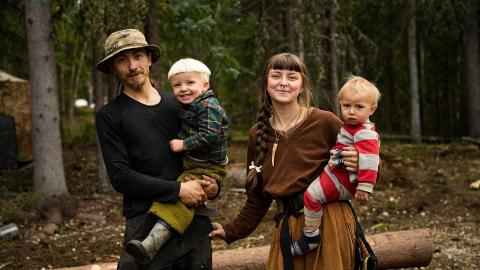Gold, trade, tillage (farming) represent the three stages in the history of colonization and the greatest of these, because fundamentally essential to permanence, is tillage.
Charles Andrews
PRELUDE
American expansion conflicts with the Mexican empire. Mexico's 1829 abolition of slavery angers many American settlers in Mexican Texas. And by 1835, Americans outnumber Mexicans ten to one. In March 1836, at an old mission, 200 Americans, including the legendary frontiersman, Davy Crockett, attempt independence. The battle of the Alamo fails. But the martyrs made inspire others, and the need to protect their slave-based economy necessitates war. This war wins Texas and California.
1848 GOLD FEVER
In the year that Mexico cedes California to America, a carpenter, James Marshall, finds a 3 inch nugget of gold in a Californian river. This one nugget is worth two months pay. Within a year, 100,000 amateur prospectors join him. Some Chinese find 100 ounces and make $26,000 in four days. In two years, the population explodes from 15,000 to 100,000. Pots, picks and shovels go from a few cents to $10 a piece. Even breakfast costs ten times what it does in the East 200 ships lie abandoned in the San Francisco port - their crews having deserted in the rush to prospect the hills.
TRADE
After just six years, the gold rush is over. Of the 300,000 hopefuls, less than one in a 100 strike it rich. But those who sold the prospectors their shovels, the merchants and the suppliers have become wealthy. And across the country, the economy is booming. Along the 3000kms of the Mississippi, the lifeline connecting the west to outside world, and the only trade route, goods have been carried on simple rafts and flat boats. Traders and farmers sometimes have to walk 1000kms home after unloading their goods and produce. The invention of the steamboat changes the mid west. Half of all early models explode, but travelling at 80kms a day, 8 times faster than a flat boat, their numbers on the river soon triple.
FARMS
America's third President, Thomas Jefferson, believed it would take a thousand generations to settle the West. It is done in just four. Because behind the exciting explorers and famous frontiersmen, there follows families and farmers. Forests are cleared at a rate of five acres per family per year. In 1800, Indiana was 23m acres of is wilderness. By 1860, it is a tamed, flat fertile farmland. Settler families live in single room log cabins sometimes housing 10 or more. They build their own furniture and live off their land. In bad years, malaria kills one in 8 of the settlers - life expectancy is half of what it is today.
It was a wild region, with many bears and other wild animals still in the woods, there I grew up. I had an axe in my hand, from my eighth to my twentieth year.
The above quote comes from one of those who tamed the wilderness. His grandfather had followed Daniel Boone into Kentucky. His father had pushed further into the forests of Indiana. Aged just nine, he had seen his mother die from poisoned milk. He will become America's 16th President - Abraham Lincoln.
Did you know?
Around the Port of San Francisco, a plot of land worth $16 before the gold rush, after, would change hands for $45,000., 186 defenders of the 200 Alamo defenders were killed, including Davy Crockett. Women and children were spared so they could go back home and spread the message 'Don't come.', Davy Crockett, the embodiment of the 'Indian' fighting, legendary frontiersman, was an unlikely opponent of the Native American ethnic cleansing law, The Removal Act. Crockett had fought alongside the Cherokee and had come to admire their tenacity and courage. His support of the Native Americans cost him a bid for political re-election and was one of the reasons he left and went to Texas, and ultimately, the Alamo.
















